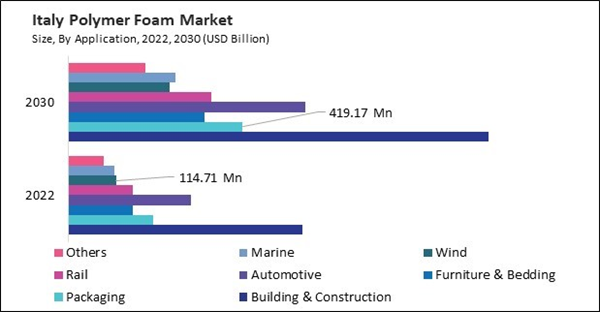In the polymer foam market, building and construction represent a significant and diverse application area. Polymer foams, such as expanded polystyrene (EPS), polyurethane (PU), and phenolic foam, are extensively utilized in various construction applications due to their lightweight, insulation properties, and versatility. Thus, the Germany market utilized 833.5 million square meter polymer foam in building and construction segment in 2022.
The Germany market dominated the Europe Polymer Foam Market by Country in 2022, and would continue to be a dominant market till 2030; thereby, achieving a market value of $12,335.8 million by 2030. The UK market is registering a CAGR of 6.1% during (2023 - 2030). Additionally, The France market would showcase a CAGR of 7.9% during (2023 - 2030).
It is used in various consumer goods applications. For comfort and support, foam is used in furniture cushions, mattresses, pillows, and upholstery. Also, polymer foams are used in helmets, padding, yoga mats, and flotation devices for safety and performance. Foams are used in the production of soft toys, play mats, and recreational floats for children’s entertainment and safety.
Moreover, foams protect sensitive electronic components, such as circuit boards, displays, and semiconductors, in the electronics sector from impact and vibration damage. Foams with high thermal conductivity are utilized for heat dissipation in electronic devices, helping maintain optimal operating temperatures and reliability. Conductive foams provide electromagnetic interference (EMI) shielding to prevent electromagnetic radiation from affecting electronic equipment and signals.
According to the Government of the United Kingdom, the GVA of the food sector (excluding agriculture and fishing) was £115.2bn in 2021, increasing by 12.3% since 2020. During this period, the GVA of the entire food and beverage industry rose, with catering, manufacturing, retailing, and wholesaling increasing by 31.6%, 8%, 5.5%, and 0.4%, respectively. The increased economic activity in the food sector translates to a higher demand for advanced packaging materials. s finds applications in the UK for packaging various food products, offering durability, flexibility, and moisture resistance. The European food and beverage industry has increasingly focused on sustainability and reducing environmental impact. This trend may drive the demand for eco-friendly packaging materials, including bio-based and recyclable polymer foams. Therefore, the expansion of the region’s food and beverage sector is propelling the market’s growth.
Based on Type, the market is segmented into Polystyrene Foam, Polyurethane Foam, PVC Foam, Phenolic Foam, Polyolefin Foam, Melamine Foam, and Others. Based on Application, the market is segmented into Building & Construction, Packaging, Furniture & Bedding, Automotive, Rail, Wind, Marine, and Others. Based on countries, the market is segmented into Germany, UK, France, Russia, Spain, Italy, and Rest of Europe.
List of Key Companies Profiled
- Arkema S.A.
- BASF SE
- Borealis AG (OMV)
- Synthos S.A. (FTF Galleon S.A.)
- DuPont de Nemours, Inc.
- Trelleborg AB
- Zotefoams plc
- Sealed Air Corporation
- Woodbridge Foam Corporation
- Polymer Technologies, Inc.
Market Report Segmentation
By Type (Volume, Million Square Meter, USD Billion, 2019-2030)- Polystyrene Foam
- Polyurethane Foam
- PVC Foam
- Phenolic Foam
- Polyolefin Foam
- Melamine Foam
- Others
- Building & Construction
- Packaging
- Furniture & Bedding
- Automotive
- Rail
- Wind
- Marine
- Others
- Germany
- UK
- France
- Russia
- Spain
- Italy
- Rest of Europe
Table of Contents
Companies Mentioned
- Arkema S.A.
- BASF SE
- Borealis AG (OMV)
- Synthos S.A. (FTF Galleon S.A.)
- DuPont de Nemours, Inc.
- Trelleborg AB
- Zotefoams plc
- Sealed Air Corporation
- Woodbridge Foam Corporation
- Polymer Technologies, Inc.
Methodology

LOADING...









